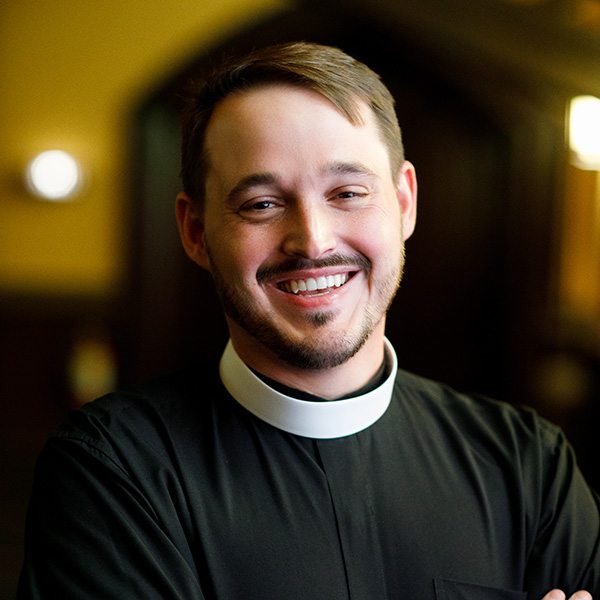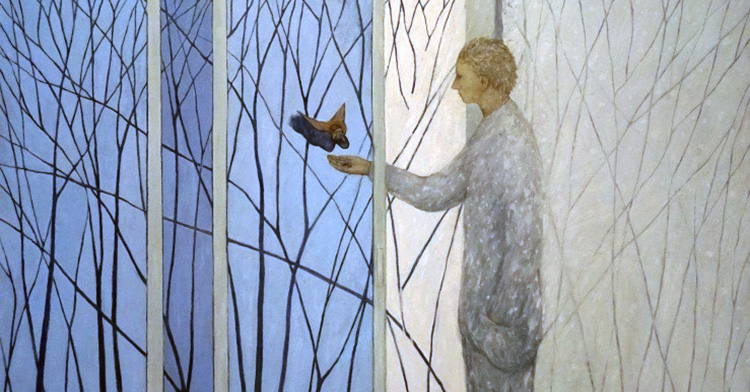From ballparks to churches, architecture has a significant impact on people’s lives and should therefore be about the creation of places where people can flourish, said David Greusel, an architect who specializes in the design of public buildings.
Unfortunately, much architecture today, both sacred and secular, has not been about human flourishing, Greusel said. Instead, architecture in general has been about originality at the expense of tradition, while church architecture has been marked by mediocrity born of pragmatism.
“The church had a central role in the discussion about what is good architecture but basically abandoned it,” he said.

Greusel has worked as an architect for more than 30 years and is the founder of Convergence Design, a Kansas City-based practice specializing in places where people gather. Earlier, while with another firm, he was lead designer for two major-league ballparks: Minute Maid Park, home of the Houston Astros, and PNC Park, home of the Pittsburgh Pirates.
Greusel writes and speaks frequently about architecture, work and faith. He is a contributing writer for the website Cardus and was a presenter at the Jubilee 2012 Conference, a conference on work and faith.
Greusel spoke with Faith & Leadership recently about architecture, work and faith. The following is an edited transcript.
Q: I understand that your approach to architecture -- in both its design and its business aspects -- is shaped by your Christian faith. How so?
A few years ago, our church started thinking about how faith and work relate to each other. And we really began to see the things we do at church and on Sunday as part of an integrated whole.
When I started Convergence Design a couple of years ago, I wanted to carry that idea into the workplace. Not that everybody who works here has to be a Christian, but just that we view our lives as an integrated whole -- that our work and our family and our community commitments, whatever they might be, should be seen as a seamless fabric rather than a series of compartments.
And in our practice of architecture, obviously, we see architecture as having a significant impact on people’s lives. Winston Churchill said, “First we shape our buildings, and afterward they shape us.”
So we take what we do seriously; we try to create places where people can flourish.
Unfortunately, I don’t think that’s always what architects try to do when they envision a space. But it’s very much what we try to do.
Q: Your firm specializes in public spaces, places for people to gather.
Yes. We specialize in “public assembly” architecture -- basically, any large building where large numbers of people are likely to come together. That includes churches, but also stadiums, ballparks, arenas, convention centers, conference centers, amphitheaters and places like that.
Q: Speak some about the nature of sacred space. I gather that for you, sacred space is not exclusive to houses of worship.
I would say that all space is sacred in that everywhere people are is important space and needs to be treated with reverence. Obviously, houses of worship are a special category, where people intentionally meet to have an experience of God.
But I take the view that there’s no square inch of creation that Jesus doesn’t claim as his. So we tend to think all space is sacred in that sense.
Q: You were the lead designer for the Houston Astros’ Minute Maid Park and the Pittsburgh Pirates’ PNC Park. Does faith bring something even to the design of baseball parks?
Those ballparks were very much about seeking the welfare of the cities where they are located. As an architect from out of town, I first try to understand the city where I’m working -- its history, traditions, architecture and people.
But beyond that, I’m trying to bring my best understanding of urban design to a large building (because ballparks tend to be very large buildings) and design it in such a way that it can help the city to flourish -- not just people in the ballpark but also people around the ballpark.
That means responding to the street in a certain way and responding to the pedestrian who’s walking by in a certain way, and really keeping all those things in mind as you design the project, not just trying to come up with a zoomy shape that’ll look good on a magazine cover.
Q: What’s your assessment of the current state of architecture broadly and church architecture specifically?
Architecture broadly, for about 100 years, has been headed off in a direction where the search for original forms of expression trumps everything else. Because of how our profession is structured, with few professional journals and a relatively small number of schools, many architects get oriented in that mindset and try to outdo themselves in originality of form.
While there’s nothing wrong with trying to express yourself in a new way, it gets carried to extremes in architecture. Often, the buildings on architectural magazine covers are buildings that most people react to negatively, yet the profession celebrates them.
So I’m trying to push back against that. I’ve been reading an excellent book by Eric Jacobsen, called “The Space Between,” that talks about the public realm.
Eric has a lot of wise counsel. He reminds us that traditions become traditions because they have value. And for the last 100 years or so, the architectural profession has been busily destroying tradition and eliminating it from the curriculum, to our detriment.
Church architecture is in a different place. Because of the fundamentalist movement of the last 100 years or so, churches have tended to treat buildings as unimportant. As churches -- in North America, at least -- focused on saving souls to the exclusion of everything else, they tended to ignore the physical facility where they worshipped and treated it as an afterthought.
Because of that, you see a lot of mediocre or less-than-mediocre church architecture that’s born out of a spirit of pragmatism, which is a very un-Christian way of looking at building.
The pragmatism comes from thinking that if it’s not related to saving souls, it’s unimportant. Therefore, buildings are unimportant -- we should just move into the cheapest, crummiest building that can keep the rain out.
That is a distortion of the creation mandate in Genesis to cultivate and subdue the earth, and a distortion of what the church is supposed to be about.
Q: You also say the church shares responsibility for the state of architecture generally and that it should care about architecture even beyond its own walls. Why?
In the history of Western civilization, the church has always been the most important, most beautiful, most expensive building in town. But if you think about the church in North America today, none of that is true.
The church is no longer important, it’s no longer beautiful, and it’s no longer expensive. It’s unimportant, cheap and shoved off to the side in our public discourse.
Most of the history of architecture is the study of religious buildings, from ancient temples through the cathedrals right up until about the middle of the 19th century, when it started to be about other buildings, like museums, schools and libraries.
The church had a central role in the discussion about what is good architecture but basically abandoned it. And that abandonment was about the same time as this interest in personal evangelism came along, and I think those two things are related.
Q: What are the most important, expensive and beautiful buildings today?
Art museums and performing arts centers are now the largest, most expensive and most important buildings in town.
Kansas City just opened an expensive new performing arts center that is enormously popular, and a few years earlier, a big addition to the local art museum.
If you ask people on the street to name the two most important buildings built in Kansas City recently, almost everybody would say, “Well, the Kauffman Center for the Performing Arts and the Bloch addition to the Nelson Gallery.” And I wouldn’t disagree.
Buildings for the arts are where people focus their attention architecturally and where they put the most resources and money.
Q: What does that mean for the church?
I think it’s bad from the church’s point of view. The arts have taken the place of the church as the place where people put -- you might say, invest -- their spiritual dollars.
People want to feel spiritual. At least, we recognize that we are spiritual beings and not just blobs of flesh.
But they invest those dollars in the arts rather than in the church, which is obviously unfortunate for the church. We’ve spent 150 years getting to that place, and it’s probably going to take us 150 years to get out of it, if we do get out of it.
Q: What about Minute Maid Park and other public spaces? Does the church have a stake in what they look like and how they function?
Absolutely, but we’ve narrowed the discussion so much that it’s going to be hard to get a seat at the table again.
Minute Maid Park is built across the street from a church, and the only real interaction that we had with that church was trying to get around the arcane Texas liquor laws that state how many feet an establishment that sells alcohol has to be from a church. That was the extent of it.
But I think the ballpark actually expresses some architectural ideas that are borrowed from the church. The intent was to make it a harmonious neighbor with the church, so I was aware of the existence of the church and kind of baked that into the design.
But it wasn’t like folks from the church were calling us up saying, “Let’s talk about how we can work together to make this a better neighborhood.” Nobody thought in those terms, and perhaps we need to be.
Being an architect, I sometimes forget Step 1, but Step 1 is to convince the church and Christians generally that caring about the built environment is part of our duty as stewards of creation, stewards of this beautiful world that we’ve been given.
We have a responsibility to care about this stuff. And if we care about it, we have a responsibility to speak up and let our voice be heard.
Q: You said that architecture has thrown out all tradition in its quest for originality. What’s the right architectural balance between tradition and innovation?
I would express it this way: I’m not interested in doing the same building that somebody did 100 or 500 years ago, but I’m interested in learning from it and building on tradition.
What’s different about the modern movement is rather than building on tradition, they swept it all away and said, “Let’s start over.” That sounds appealing when you’re in a revolutionary mood, but there’s a lot of wisdom that goes out the window when you do that.
My interest is not in replicating the classic forms that are found in the 500-year-old pattern books but in learning from and being informed by them to design buildings that look like they’re part of a conversation where a building can be more contemporary than its peers but it still looks like it fits in with its peers.
One of the main critiques of modernism generally is that the buildings never look like they fit in. They look like they’re the one guy at the party wearing a bunny suit, and they don’t seem to be able to have a conversation with their peer buildings.
That’s something I’m sensitive about. I try to make buildings that look like they’re part of a community and not something that got dropped from a UFO.
Q: Your firm’s slogan is “a particular space for a particular time in a particular place.” You don’t sit in an office and design a generic building to drop down in a vacant lot.
Right. Part of my method is to immerse myself in a community where I’m going to be designing a building and figure out what makes it tick. What’s neat about it? What’s unique? What ethnic heritages do people bring to the table?
I try to understand and absorb all that before I design anything, so that the building looks like it’s part of the community and not just something brought in from outside. That immersion and understanding is an important part of the design process.
But other architects keep repeating themselves over and over again, regardless of what city they’re in. Their work seems to be very popular, and they’re highly celebrated architects. So I can’t say that my method is better; it’s just my method.
Q: What’s a well-designed church supposed to do?
A well-designed church is supposed to put people in a proper frame of mind to think about and experience and have an encounter with God. That’s a really heavy responsibility for the architect of a church.
So I -- not having any great confidence in my own abilities -- look around and ask, “How has that been done in the past?” And I see these amazing Gothic cathedrals and amazing Classical churches of antiquity, and wonderful Colonial churches in New England.
And I say to myself, “Well, those folks got it mostly right, so there’s probably a lot I could learn from them.”
So I try to let myself be taught by the people who have gone before rather than assuming that I know everything and can completely imagine from whole cloth what a worship-experience space ought to be like.












